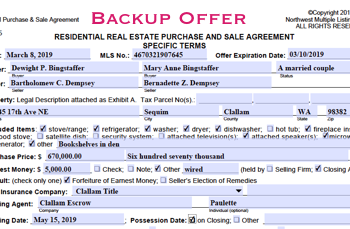Clients often ask me how to buy a short sale. Buying a foreclosure or a short sale is substantially different than buying a home from a homeowner that is not a distressed sale. The procedure, the negotiations, and the entire process from making an offer to closing is quite different, and this is why the question how to buy a short sale is so relevant. I just sold a short sale, and I’ll explain the process below.
How to Buy a Short Sale – What is a Short Sale
 Banks only accept a loss and approve a short sale if certain conditions are met. Sequim short sales require that sellers complete an extensive application, and they must persuade the bank that they have little or no assets to their name, no financial resources from any other source, and their income must be insufficient to continue to make the full mortgage payments. The sellers have to provide written third party proof with bank statements, tax returns, and often a great deal of additional documents. There is more to the question about how to buy a short sale than meets the eye at first.
Banks only accept a loss and approve a short sale if certain conditions are met. Sequim short sales require that sellers complete an extensive application, and they must persuade the bank that they have little or no assets to their name, no financial resources from any other source, and their income must be insufficient to continue to make the full mortgage payments. The sellers have to provide written third party proof with bank statements, tax returns, and often a great deal of additional documents. There is more to the question about how to buy a short sale than meets the eye at first.
How to Buy a Short Sale – The Short Sale Addendum
The language for contracts for Sequim short sales has been meticulously drafted and worked out by many lawyers and the banks and their lawyers, and this language is part of the Short Sale Addendum. The language includes specific instructions to all parties, including this paragraph:
SHORT SALE CONTINGENCY. This Agreement is contingent upon Seller obtaining written consent from Seller’s creditor(s) for the Short Sale and Seller’s acceptance of any conditions imposed by Seller’s creditor(s) (“Lender Consent”). Seller shall have ___ days (60 days, if not filled in) after mutual acceptance to obtain Lender Consent. If Seller timely gives notice of Lender Consent to Buyer, then this contingency shall be deemed satisfied. If Seller fails to timely give notice of Lender Consent to Buyer, then this Agreement shall terminate and the Earnest Money, if deposited, shall be refunded to Buyer. If Seller becomes aware that Seller’s creditor(s) did not consent to the Agreement or if Seller decides not to accept the conditions imposed by Seller’s creditor(s), Seller shall give notice to Buyer of that fact within 2 days and upon Seller’s notice, this Agreement shall terminate and the Earnest Money, if deposited, shall be refunded to Buyer. Buyer and Seller acknowledge that Seller has limited control over whether Seller’s creditor(s) will consent to the sale and when such consent is given.
How to Buy a Short Sale – Example
I just sold a short sale in Sunland in Sequim, and here’s the process. The home is being sold by a widow. Her husband passed away not long ago. The sales price was $180,000. The first bank loan has a balance of about $180,000, so the bank will take a loss to sell this home at that price, but not as large a loss as many banks have had to take. But there is a second for about $50,000. The risk of a second is that you may not get paid if there is a foreclosure or the market goes down. That’s the case here. And there is a third for $100,000, which is an IRS tax lien. The IRS will waive their lien since there will be no proceeds from the sale for the IRS. Under the law, the IRS has 45 days to make a claim or waive their lien. This is one of the reasons a short sale often takes a long time. Procedurally, all of this must be handled precisely under the relevant law and agency guidelines.
The process can be quite involved. Few Realtors know how to buy a short sale, and handling a short sale is not for the feint of heart. I’m glad my background includes practicing real estate law for 20 years as that now redounds to my clients’ benefit on short sales. Now you know more about how to buy a short sale.
Last Updated on July 15, 2012 by Chuck Marunde
































